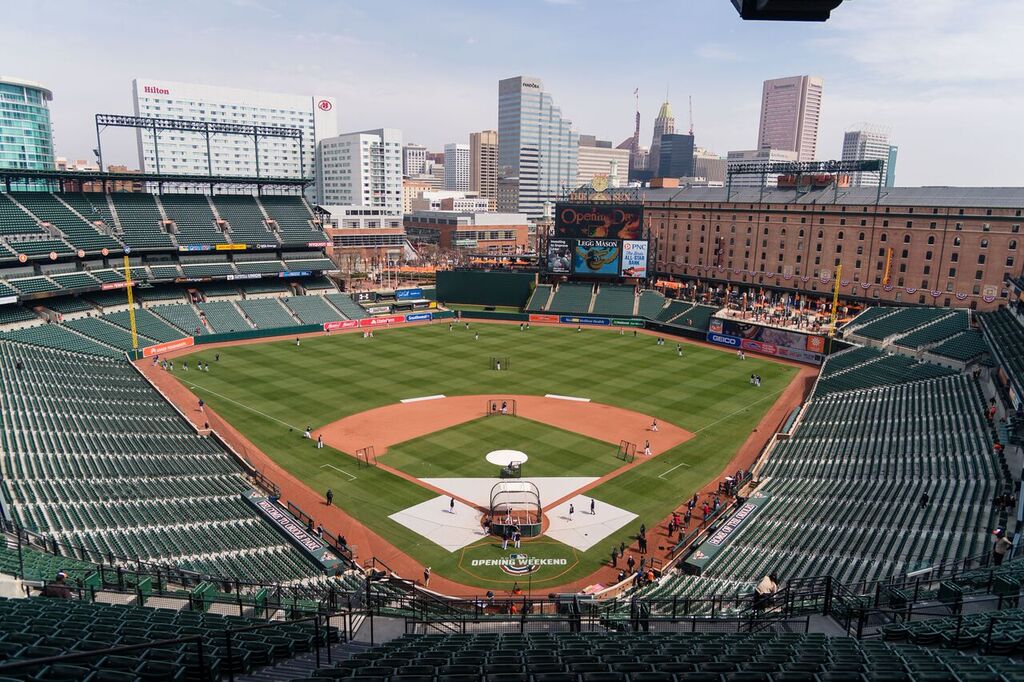Baltimore Orioles lead Major League Baseball in boredom
Oriole Park at Camden Yards Opening Day 2018 (Michael Jordan/BPE)
BALTIMORE — If you want the truth of it, major league baseball has become a major league bore.
I say this not only because my beloved Baltimore Orioles are playing with all the skill of Pony Leaguers, but because this year, in their summer of discontent, they’ve come to epitomize the precise troubles plaguing the sport at its highest level.
They’re a hit-or-miss team in a modern hit-or-miss game. Baseball has sold out to the mighty home run, but in the process fallen victim to the pathetic strikeout. The baseball goes bye-bye, or it goes nowhere at all.
And, as this happens with increasing familiarity, nobody on the playing field moves an eyelash for long minutes at a time while thousands of distracted fans peruse the stock market tables on their phones, discuss the weather with seatmates, head out for an overpriced drink and an under-heated hot dog, and stifle a series of yawns.
This is happening all over major league baseball, but its effects have been felt profoundly this summer in Baltimore, where the Orioles have now dropped more than 40 games below .500 and seem headed for their worst season ever.
That’s pretty remarkable, considering this is the franchise that set a major league record in 1988 by opening the season with 21 straight losses. They finished at 55-107 that year. They’re now on a pace that threatens even that level of ignominy.
And they’re doing it in the modern fashion that not only leads to losses, but to excessive boredom.
Across major league baseball, when players aren’t hitting the ball out of the park, they’re not hitting it at all. Take the Orioles’ Chris Davis. For much of the season, he’s hovered around the .150 mark. That is not a misprint. Over the last three seasons, he’s averaged more than 200 strikeouts. Neither is that a misprint.
Over the weekend, Davis tied Cal Ripken for the Orioles record of most strikeouts in a career. The difference is that Cal did it in nearly 12,000 at-bats across 21 seasons, famously taking no time off. Davis has done it in just 3,500 at-bats across less than 8 seasons with Baltimore, famously taking time off when benched or suspended for substance abuse.
He’s not the only all-or-nothing example on the Orioles, just the most glaring. Davis once hit 53 homers in a season. We’re past the halfway mark of the 2018 season, and he’s got 8.
But neither Davis’ strikeouts nor his batting average are anomalies anymore. In baseball, it used to be that anyone hitting below, say, .230 was considered a borderline major leaguer. The other night, there were 41 major leaguers in their starting lineups who were hitting .200 or under.
By Major League Baseball’s own statistics, it gets worse.
For the first time in history, the game’s on a pace for more strikeouts than base hits. Batters are striking out a mind-numbing 22.5 percent of all plate appearances. They’re either striking out, walking, or hitting a home run in 34 percent of their plate appearances. What does that mean? It means there’s no action on the field more than one-third of the game.
We’re seeing new levels of players adjusting their cups to have something to do between pitches.
According to Sports Illustrated, the average time between balls put in play is now 3 minutes and 45 seconds.
In that length of time, football teams are running off half a dozen plays. Basketball teams are up and down the court a dozen times. Quoits moves faster.
In the National League, where pitchers still (you should pardon the expression) “hit,” there are only four teams with more hits than strikeouts.
How does all this translate? Check your home team’s attendance. Every night at the ballpark, there are thousands of fans posing as empty seats. Attendance is down 6.5 percent since last year – the biggest drop in more than two decades.
Of the 18 teams whose attendance has dropped, five are down more than 200,000 and one – the Toronto Blue Jays – is down more than 400,000.
And the Orioles? Don’t ask. The team that once routinely drew well over 3 million fans a year won’t approach 2 million this year.
It’s not just that they’re bad (and likely to get worse once they’re forced to trade their best player, Manny Machado, because they can’t afford him.) It’s that they’re boring, too.
In a sport whose entire style of play resembles a still-life, boredom is the one quality where the Orioles lead the league.

Michael Olesker, columnist for the News American, Baltimore Sun, and Baltimore Examiner has spent a quarter of a century writing about the city he loves.He is the author of several books, including Michael Olesker’s Baltimore: If You Live Here, You’re Home, Journeys to the Heart of Baltimore, and The Colts’ Baltimore: A City and Its Love Affair in the 1950s, all published by Johns Hopkins Press.

